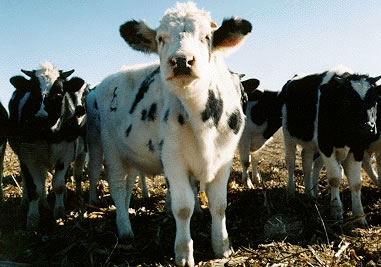Posts Tagged: Frank Mitloehner
San Francisco meeting generates research buzz
A meeting this week of the American Chemical Society turned two interesting UC research projects into headline news.
UC Davis nutrition professor Paul Davis reported that walnuts slowed prostate tumors by 30 percent to 40 percent in mice, according to a UPI article. The dose was equivalent to 2.5 ounces for a typical man. Not only was prostate cancer growth reduced, but the mice had lower blood levels of a protein that is strongly associated with prostate cancer.Completely unrelated research presented at the meeting, also from UC Davis, questioned an often-quoted UN statistic that said animal agriculture produces 18 percent of greenhouse gas emissions, more than all transportation combined.
Air quality specialist Frank Mitloehner says the U.N. reached its conclusions for the livestock sector by adding up emissions from farm to table, including the gases produced by growing animal feed, animals' digestive emissions, and processing meat and milk into foods. However, for transportation it only considered emissions from fossil fuels burned while driving, according to a CNN story.
"This lopsided 'analysis' is a classical apples-and-oranges analogy that truly confused the issue," Mitloehner was quoted in the original UC Davis news release announcing his results.
At least one blogger wasn't fully convinced that the world can go back to eating meat guilt free. The writer of Guardian UK Environment Blog, Leo Hickman, wondered why more media outlets hadn't reported that Mitloehner receives a significant amount of research funding from the meat industry."I'm not saying that Mitloehner is a bought-off scientist in the pocket of Big Beef. . .," Hickman wrote. "My beef is that this funding information has not been deemed worthy of inclusion in the reports and blogs that have been so quick to leap on Mitloehner's findings as, in their eyes, further proof that environmentalists are just a bunch of unscientific cranks."
The American Chemical Society's national conference concludes today.

Frank Mitloehner
Pollution regulations stymie dairy electricity generation
For Central Valley dairies, conflicting laws are making it hard to generate green electricity from dairy waste, according to an article this week in the Los Angeles Times.
In order to reduce emissions of methane - a greenhouse gas - some dairy operators have installed methane digesters that convert the methane into electricity.
However, the process produces nitrogen oxides (NOx), which react with volatile organic compounds to create ozone, a significant air pollution problem in the San Joaquin Valley. NOx levels for the valley, a region with air pollution among the most severe in the country, is set by federal officials and enforced by the San Joaquin Valley Air Pollution Control District.
The district is requiring expensive modifications on digesters, which in some cases shuts the equipment down altogether. Air district officials told the LA Times they're just doing their jobs. "Combating smog, not climate change, is the agency's mission," Times reporter P.J. Huffstutter wrote.
Modesto dairy operator John Fiscalini spent hundreds of thousands of dollars on a catalytic converter and other filtering equipment to meet the air district's limit of 11 parts per million of NOx for his digester system.UC Davis Cooperative Extension animal scientist Frank Mitloehner told the Times that works out to equal the emissions of 26 cars for every 1,000 cows.
"They have a point. I want clean air," Visalia dairy farmer Ron Koetsier was quoted in the story. "But it doesn't make financial sense for me keep doing this. I don't see how they can turn methane gas into electricity in California, given these rules."

Dairy cow in California.
UC helps Marin dairy operators clear the air
UC Cooperative Extension provided Marin ranchers and dairy operators exposure at a two-hour workshop Feb. 2 to the latest conservation practices that can help the agriculture industry reduce its environmental impacts and increase farm and ranch energy efficiency.
In addition to local farmers, reporter Rob Rogers was at the event collecting information for an article published in the Marin Independent Journal yesterday.Rogers reported that cows produce a smaller percentage of greenhouse gases in the United States and Europe than in other nations, where farming is a larger part of the economy, and where it's practiced less efficiently. According to the United Nations, livestock produce about 18 percent of the world's greenhouse gasses. In the U.S., livestock is responsible for just 5.8 percent of total greenhouse gas emissions.
Workshop speaker Frank Mitloehner, UC Davis air quality specialist, said research shows that it is cows - not waste storage lagoons - that emit most methane and nitrous oxide on dairies.
"Lagoon waste is so heavily diluted that it's a smaller factor than fresh waste," Mitloehner was quoted in the story.
He offered solutions that may not sit well with organic producers:
-
Produce more milk with fewer cows by increasing efficiency.
-
Cut back on grass-fed cattle, which, because of extra roughage, produce more methane.
Albert Strauss, an organic dairy farmer who also spoke at the meeting, noted that reducing cow emissions is only part of the environmental picture. One option for reducing dairy emissions is converting waste into energy with a methane digester. Using this technology, the Strauss operation meets its own energy needs and will soon be selling extra energy back to PG&E, the article said.

dairycow

